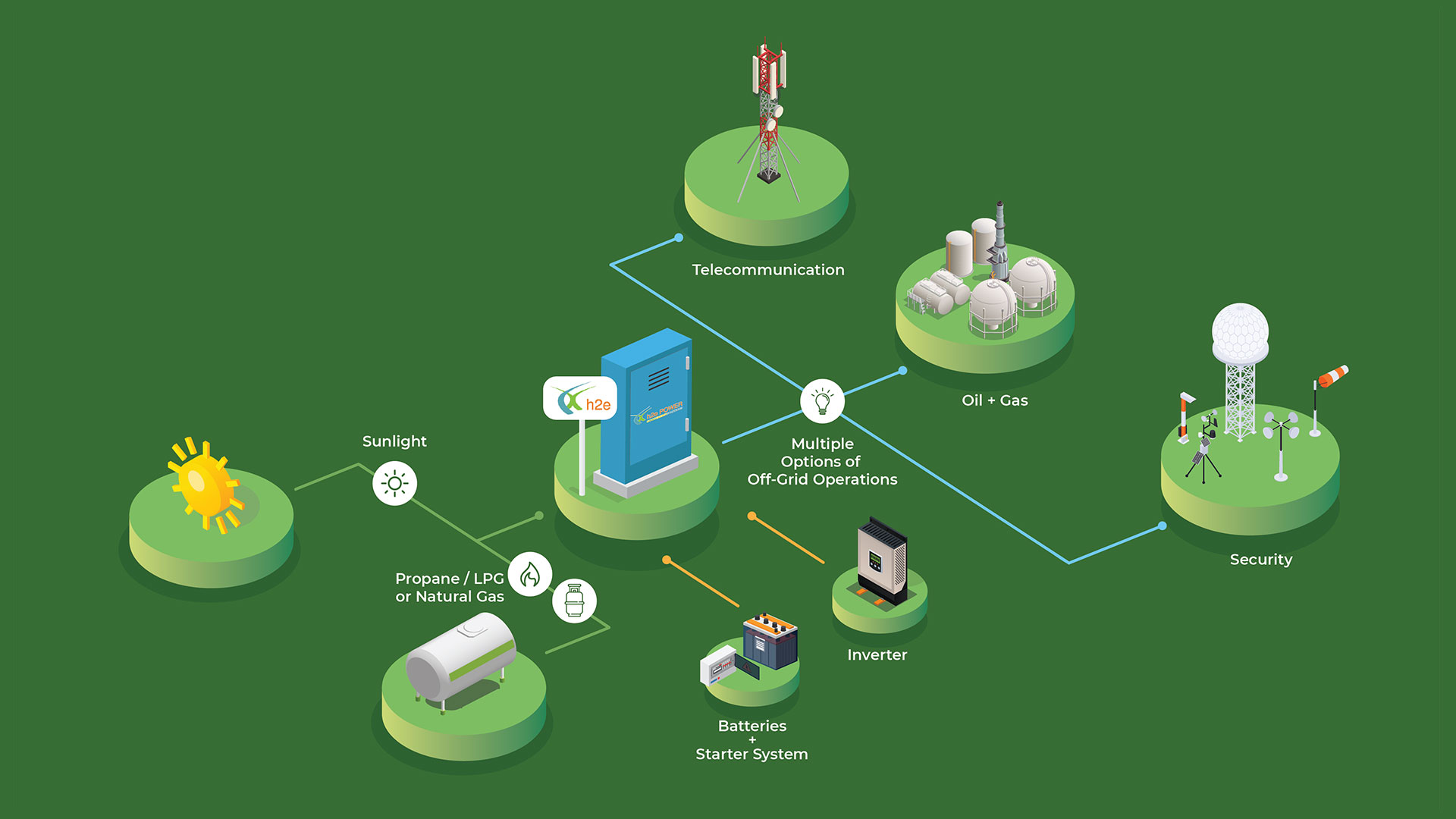SOLUTIONS
On Grid and Off-Grid Power
H2e Power
Independent Power System
A reliable, durable and independent off-the-grid power supply is crucial to remote regions without access to an electricity distribution system. Quite often, challenging weather conditions obstruct standard alternatives such as internal combustion engines or renewable energies (wind, solar).
H2e-Power Box systems provide an autonomous power supply in extreme temperatures, strong winds and high humidity or in sandy and dusty environments. Based on solid oxide fuel cells (SOFCs), they efficiently produce electricity, thus ensuring the uninterrupted operation of critical industrial processes, such as gas pipelines or telco transmitter stations.
Clean and Cost-Efficient Solution

Power Supply for Remote Regions

Oil and gas industry
- Cathodic corrosion protection
- Remote block and gate valve
- Pressure-reducing stations and metering systems
- SCADA systems
- Remote monitoring and observation equipment
Telecommunication
- Microwave repeater stations
- Radio transmitter
- Cellular base stations


Others
- Mountain huts
- Meteorology stations, e.g. Radar, Sodar and Lidar
- Traffic engineering, e.g. barrier systems and lighthouses
FREQUENTLY ASKED QUESTIONS
F.A.Q.
In principle, fuel cells could power anything that requires electrical energy to function. This could range from a mobile phone up to a city. Current commercial applications include off-grid power for telecom stations; back-up power for buildings; drives for forklift trucks; residential heat and power; portable generators, recharging devices, and electric vehicles. Megawatt-size fuel cell power plants could supply power to industrial plants and cities.
A battery chemically stores and releases electricity, while a fuel cell produces energy through the electrochemical reaction of a fuel and air. A battery will run out of power and require recharging, then disposal. A fuel cell, however, will continue to function and produce power as long as fuel and oxygen are supplied.
The h2e® fuel cell system is a generator that converts gaseous hydrocarbon fuels (e.g. PNG/CNG) into electricity. The process is quieter, more efficient, and cleaner than conventional, engine-driven generators.
The h2e® fuel cell system is fuel flexible and can use a variety of fuels such as natural gas, liquefied petroleum gas, methane, and hydrogen. Energy from landfills, biomass, coal, wood, and agricultural waste can also be used to create the fuel. Because they function on such diverse input, fuel cells are a logical choice to transition from current combustion-based technologies to renewable energy sources.
The h2e® fuel cell system can be used for stationary applications to fulfil the heat and power demands of the Residential, Commercial, and Agricultural sectors.
The h2e® fuel cell system is equipped with a ceramic SOFC, based on patented Fraunhofer technology. Using a process called catalytic partial oxidation, hydrocarbon fuels like PNG, CNG & LPG can be converted into a hydrogen-rich fuel gas. This fuel gas is directly converted into electricity in the SOFC fuel cell.
The SOFC is the simplest fuel cell technology as it does not require extremely pure fuels such as hydrogen, unlike other fuel cells. It is also the most inexpensive fuel cell because it does not contain noble metals, e.g. platinum. The active part of the SOFC can be as hot as 830°C. High-performance ceramic insulation, however, reduces the temperature on the outside to hand-hot. A patented, internal heat-recovery system makes sure that heat losses from the system are reduced to a minimum, which means a low exhaust gas temperature just like on other fuel cells.
The h2e® has no moving parts and requires little maintenance. A majority of the system components are maintenance-free and a few components that require maintenance have long maintenance intervals. The h2e® is assembled with DIN modules to reduce the time required for the repair and maintenance.
The h2e® fuel cell system can be operated with PNG, CNG, and Biogas, which is conveniently available everywhere around the world. Proprietary cartridges with potentially hazardous fuels are not necessary. At the same time, the system is small and lightweight since there is no need for water management. As the system runs completely without water it can easily be started and operated even during freezing conditions.
Yes. It is possible to purchase a fuel cell as a power source instead of a battery or diesel generator, for instance. The price of the system will be very competitive in comparison to similar fuel cell systems of the same power range. The cost of fuel, however, will be much lower than with proprietary solutions, as it uses commonly used fuels available almost everywhere at a low cost.
The h2e® fuel cell system currently undergoing an intensive test and evaluation phase to ensure the best possible user experience. Kindly contact us for more details.
